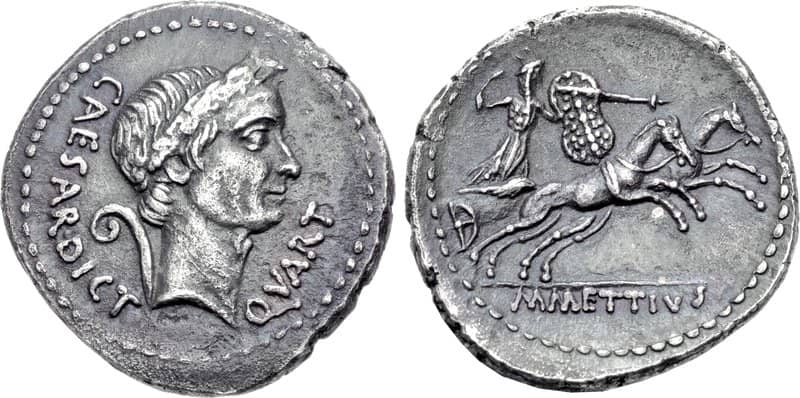Last Updated on January 20, 2025
The Weimar hyperinflation of 1923 has become the poster child for hyperinflation horror stories.
It was one of the world’s worst periods of hyperinflation and unleashed financial, political and social chaos on the German nation.
It resulted in the initial crash and subsequent speculative bubble in the stock market, the destruction of the currency and prompted Hitler into his first attempt to seize power.
While such a rapid destruction of an economy is not a regular occurrence, the Weimar story provides a valuable insight into the process of inflation and gives a lesson into how to protect yourself from an erosion of purchasing power.
The lessons you can learn from the Weimar Hyperinflation are:
- Learn how to protect yourself from hyperinflation
- Diversify beyond your home country
- Be prepared to invest in a crisis
- Consider the agricultural sector
When Did Hyperinflation Start In Germany?
Let’s start the story in 1921, two years before when people commonly think the Weimar hyperinflation began.
During the second half of the year official food prices rose 50%.
Children were so malnourished that a study found that they were two years behind both physically and mentally for their age. Milk was only available for the sick during the winter. Poor women would scrounge through the garbage of wealthier households, hoping to find sustenance for their children.
Things were bad in post-war Germany, but the worst was yet to come.
As the German mark was falling rapidly it made no sense to save money, as its value would be destroyed. People rushed out to spend it instead, desperate to exchange the money for something real instead.
By 1922 price rises of 100% were occurring within a month.
People began to turn to barter or foreign currencies as these had a stable value. In response, the government brought in new regulations on the purchase of foreign currency. However investors could still find safe habour in foreign stock exchanges, where they could hold assets denominated in another currency. Despite the government ban black market speculation in foreign currencies thrived.
Strikes occurred as workers demanded that their wages rise to meet the rapidly rising cost of living. While wages did rise, they did not keep pace with the cost of living.
Between the war’s end in November 1918 and November 1922 wages it is estimated that wages may have risen up to 200 times, while the cost of living had increased 1500 times. The unions gradually lost influence as they could not deliver higher wages and subscriptions fell.
In January 1923, the French and Belgians invaded the Ruhr, Germany’s industrial heart. This was due to the German government’s failure to meet their post-war reparation obligations under the Treaty of Versailles.
Rather than restart payments, the German workers went on strike and the government cranked up the printing presses to pay the striking workers.
1923 became known as the year of the wheelbarrow, as the country was awash in so much paper currency that people needed wheelbarrows to carry it all around.
People wallpapered their house in paper money and children used blocks of notes as toy building blocks. People queued for hours for basic foodstuffs, prices rising dramatically while they waited.
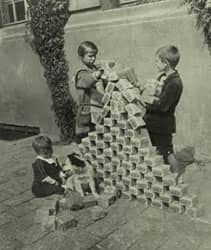
Shortages occurred due to farmers refusing to accept paper marks in exchange for produce. Politicians feared that urban mobs would descend on the countryside to help themselves.
Personally, I don’t blame the farmers. It seems pretty reasonable to reject worthless paper and demand something that would hold its value.
The economic destruction caused a desperate population to turn to the political extremes for a solution. Communist movements were growing and Hitler embarked on his famous and ill-fated Beer Hall Putsch in Munich in November 1923.
When Did The Hyperinflation End In Weimar Germany?
The hyperinflation was only brought to an end with the creation of a new central bank, who issued a new temporary currency called the Rentenmark.
The Rentenbank was established on 15 October 1923 and the new Rentenmark went into circulation on 15 November 1923.
Printing of the old marks was stopped and they were convertible to the new currency at a fixed rate of a trillion to one.
The supply of the Rentenmark was limited and it was backed by mortgaged land and industrial goods and also pegged to the US dollar at a fixed rate.
This finally brought stability to the German economy. The nightmare was over.
But how was this devastating event even able to occur?
What Caused The Hyperinflation In Weimar Germany?
Many people believe that the cause of the famous hyperinflation in Weimar Germany in 1923 was money printing that began as a result of the French occupation of the Ruhr that began in January that year.
However, the causes go much deeper.
Prior to the Great War, most major currencies were on the classical gold standard including the British Pound and the German Goldmark. A gold standard is a monetary system where the supply of banknotes in circulation is constrained by the quantity of gold in a central bank’s vault.
In Germany’s case, prior to 1914, no less than one-third of the notes issued had to be covered by gold.
In 1914 the Germans, along with all the other powers, believed that they were going to engage in a short sharp war that would be over by Christmas. The government didn’t want to finance the war through taxation, so they did so by borrowing and through the printing press.
Germany came off the gold standard and started inflating the money supply.
This initial money printing combined with the loss in the Great War, the reparations and then finally the money printing of 1923 all combined to bring about the devastating hyperinflation.
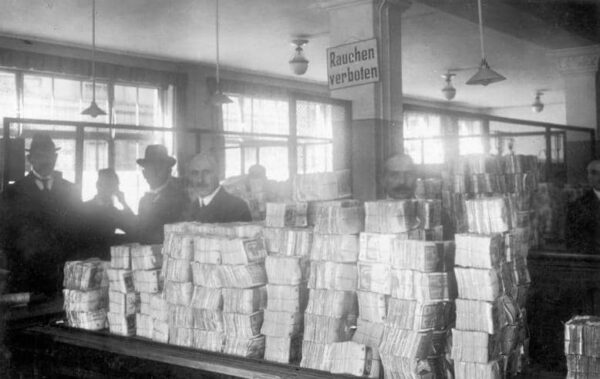
Why Did The Mark Inflate So Rapidly?
The mark inflated so rapidly in 1923 because of all the inflationary momentum that had built up from the start of the war. The money printing in 1923 was merely the straw that broke the camel’s back.
Prices rose significantly during the war, although at the time it was unclear whether this was due to shortages or inflation or both.
By the end of the war in 1918 it became clear that Germany was not just facing a military defeat, but economic ruin. Society was in upheaval as the Kaiser abdicated and fled and the new Weimar Republic faced threats from German communists.
In 1919 the Allies met in Versailles to negotiate the terms of the peace, determining that Germany should shoulder the blame for starting the war and therefore would have to pay significant reparations. In 1921 this figure was fixed at £6.6 billion with repayments set at 100 million per year.
While all of this was unfolding the inflation that began at the start of the war continued and was gathering pace throughout 1921 and 1922.
In January 1923 French and Belgian troops marched into the Ruhr, in response to Germany’s failure to pay reparations. Their aim was to receive their reparations in goods. The Weimar Government responded with a policy of passive resistance, refusing to have German workers do the bidding of the French.
This led to a further weakening of the mark, a decline in government revenue and ultimately a rapid increase in money printing.
This money printing wasn’t the start of the great hyperinflation of 1923 but rather the final act that sent an already declining currency into a death spiral.
As the crazy amounts of money printed completely destroyed the economy, destroyed the currency and caused havoc in German society.
The Effects Of Hyperinflation In Germany
Economically, the effects of hyperinflation were devastating.
People’s life savings were destroyed and the general population suffered a massive decline in their standard of living. Huge numbers who had previously been financially secure were made destitute.
Hyperinflation brough complete economic chaos as the economy ground to a halt.
As people’s savings and wages were wiped out political discontentment and social unrest grew. Both the Nazi Party and the Communist Party were beneficiaries of this as people lost trust in the centre of politics and in the Weimar Republic as a whole. The nation became very difficult to govern.
Weimar Germany recovered in 1924 with the help of American loans but the effects of the hyperinflation lingered long in the consciousness of many Germans and ultimately was a factor in Hitler’s rise in the early 1930s.
The Weimar Republic Stock Market
One interesting and often overlooked aspect of the Weimar hyperinflation saga is the performance of the Weimar stock market.
Adam Fergusson, in his famous book When Money Dies, notes that stocks went up in nominal terms during and after the war.
But in real terms the index has lost 66% from its pre-war level in 1913 to the end of the war in 1918.
By 1921, it had lost 80% in real terms compared to its 1913 level and by October 1922 it had lost 97%. The average dividend yield in October 1922 was 0.25%.
However, October 1922 was the bottom. After that stocks rose in spectacular fashion both in real and nominal terms.
Adam Fergusson explains:
October 1922, however, was the nadir for shareholders. From then on not only did money find its way back into shares, but people who could obtain cheap credit, or were unable to send their money abroad, began to realise the advantages of buying up their own country’s industrial and other assets at a fraction of their true value. Although in real terms the stock market began to go up, the mark’s purchasing power continued to go down.
It is interesting to note that this bottom occurred prior to the invasion of the Ruhr and the subsequent money printing.
The Weimar hyperinflation shows that stocks were an effective protection against hyperinflation because they are hard assets. When the currency is depreciating people want to own real stuff.
Lessons From The Weimar Hyperinflation
1. Learn How To Protect Yourself From Hyperinflation
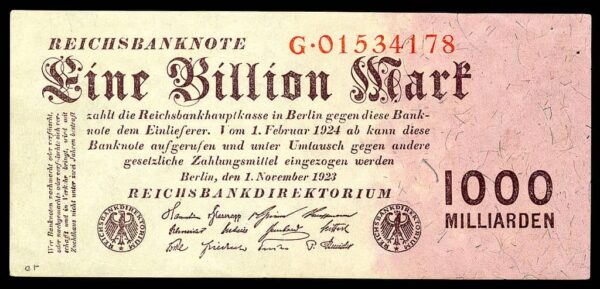
The need to protect yourself from high inflation in the current monetary environment is all too real.
Economists often define hyperinflation as a very high inflation, where the monthly inflation rate is higher than 50%.
However, to see inflation (or hyperinflation) as merely a rise in prices is to miss the point. Prices are rising, but the more accurate way to view the phenomenon is that the value of the currency is falling. Over time, the value of goods and services that one unit of currency can buy diminishes.
At an inflation rate of say 2-3%, I don’t mind holding currency. I don’t want to hold large amounts of cash for extended periods of time, but when my salary hits my bank account I don’t rush out to spend it.
But when the value of the currency falls quickly, people want to hold onto anything but currency. In Weimar Germany people rushing out to buy goods before prices rose were really rushing out to sell currency before its value fell further. They wanted to rid themselves of something that was rapidly depreciating.
Rather than an arbitrary 50% measure, it is under these circumstances where you get the “hyper” part of hyperinflation, because the basic law of supply and demand also applies to currency. If everybody is selling and no one is buying, then the value is going to fall rapidly. The phenomenon of everybody selling all at once with no buyers, is what tips a currency into hyperinflation.
It wasn’t that real goods and services, like food, didn’t exist in Weimar Germany. It was just that without a stable currency, the entire economy ground to a halt.
The scary thing is that Germany is no banana republic. It was a highly educated, modern and technologically advanced society that had contributed much to global science, technology, art and culture. Prior to the Great War, Germany was a major global power and her influence was rising.
That the destructive phenomenon of hyperinflation could occur in a country like Germany is a lesson to us all. Yes the circumstances were unique, with the war, the Treaty of Versailles and the reparations. But Germany was not destined to go down that path, it was poor policy decisions that turned manageable economic hardship into total economic chaos.
Many commentators talk about the threats of a modern day Weimar style hyperinflation occurring in the USA and other developed economies. I feel this fear is only partially accurate in the sense that Germany faced unique post-war situations and made decisions that led to a rapid collapse. The speed with which the currency collapsed in Weimar Germany was astounding.
Our experience so far is different in that is slow and drawn out by comparison and it will continue to play itself out in its own unique way. It is probably more akin to the inflation of the Roman Empire which occurred over several hundred years.
The key factor that could likely make the current situation much worse than Weimar is that due to the global supremacy of the US Dollar, any crisis in the US will be felt all around the world. All fiat currencies are linked and the US Dollar is at the centre.
The German mark was not the global reserve currency. The US Dollar is. So if we did get Weimar style hyperinflation in the US it would be an unprecedented event in history.
The crisis in Weimar Germany was contained to that country. Financial crises in the 21st century are contagious.
Whether or not a future crisis will be worse than Weimar is up for debate. My pick is that the scale will be worse but it won’t have the same rapidity and intensity. But I could very well be wrong.
Nevertheless it is worth understanding what economic Armageddon looks like. We don’t have a Treaty of Versailles or reparation payments, but we do have a steady inflation and destruction of purchasing power due to fiat currencies. The need to protect yourself is still there.
The key to protecting yourself is to own hard assets such as gold, silver, Bitcoin, Monero, real estate or value stocks.
If you look at any chart of either currency creation or the price index in post war Germany you will see a parabolic move upwards. Yet if you look at a chart with prices measured in gold, you see some fluctuation but something remarkably steady in comparison.
Quite simply, hard assets offer the best protection.

2. Diversify Beyond Your Home Country
One of the key lessons for investors from this crisis is the need to diversify beyond your home country.
Most likely you are employed, own property, hold savings and have investments in one jurisdiction.
While you might hope that your home country will be immune from economic difficulties in the future, this is somewhat risky.
Diversifying into precious metals, cryptocurrencies, foreign currency, foreign real estate or shares denominated in foreign currency will protect you from the political and economic downside risks that may be present in your own country and in your own monetary system.
Germans who were able to do this were protected and were also positioned to profit.
3. Be Prepared To Invest In A Crisis
It was mentioned previously that by October 1922 the German share market had lost 97% of its value compared to its 1913 levels.
However, that was the bottom. While the currency crisis raged on in 1923, from October 1922, those who had the means to do so were able to invest in their country’s industrial assets at “a fraction of their real value.”
It would require great courage but this was a perfect contrarian crisis investing moment where the market had overcorrected due to a politically included economic crisis and shares were available at great value.
Imagine if you were a German who had gone into gold in 1914 (or even 1918) and then into shares at the 1922 bottom. You would have done very well.
4. Consider The Agricultural Sector
In times of monetary crisis there are few better industries to be in than agriculture.
People still need to eat and the economy needs farmers to produce the food. In Weimar Germany in 1923 farmers were less affected than the urban population and did in fact manage very well.
They largely produced their own essentials, could barter locally and were able to put up their prices as needed. There are stories of those living in the towns being outraged by the behaviour of cashed up farmers who would come into the urban areas to buy things like grand pianos, given that such items would preserve their value against inflation.
Therefore it makes sense to have some exposure to the agricultural sector as a way of preserving wealth and protecting against inflation. Food production is mankind’s oldest industry and its not going out of business anytime soon.
In fact this is one of Jim Roger’s favourite investment picks.
Conclusion
Germany, like all countries, went through tough times during the war. But they went through some more tough times soon after. As their currency was destroyed, people’s life savings disappeared and everyday life became an enormous struggle.
The causes of the Weimar hyperinflation of 1923 are not limited to events of that year. Their genesis is in the way Germany financed the war and the ending of the gold standard. Post-war events then amplified these problems and poor policy decisions led to runaway hyperinflation.
While this scenario is unlikely to occur in the near to medium term future, there are lessons that modern day investors can learn from Weimar Germany’s experience of hyperinflation. The key thing is to take steps to protect your wealth from inflation, which may include precious metals or value stocks in industries such as agriculture.
It would also be wise to invest outside your home country to protect from country specific risk. Political and economic crises often present investment opportunities and, while we can’t go back to 1923 and buy up cheap German shares, understanding what happened then might help you to spot the next crisis investing opportunity.
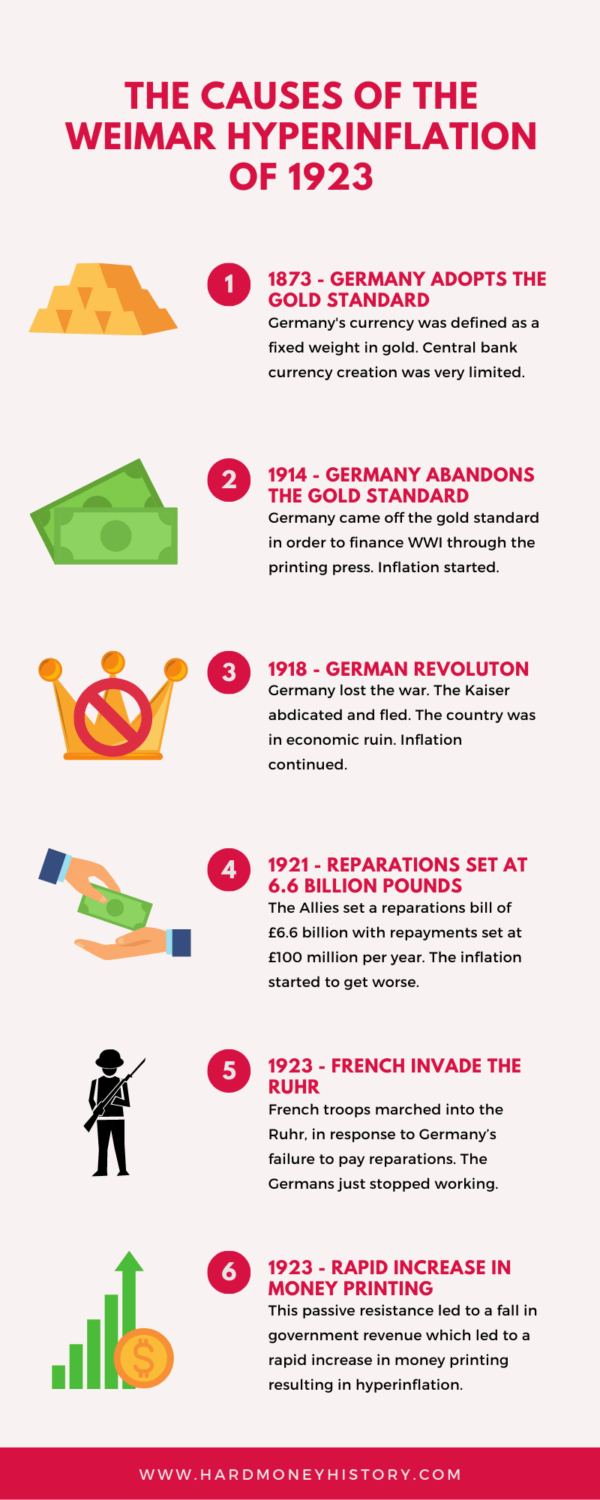
Sources
Costantino Bresciani-Turroni. The Economics of Inflation: A Study of Currency Depreciation in Post-War Germany 1914 -1923. New York, Ny: Kelley, 1968.
Fergusson, Adam. When Money Dies: The Nightmare of the Weimar Collapse. London: W. Kimber, 1975.
Graham, Frank. Exchange, Prices, and Production in Hyperinflation Germany 1920-1923. New York: Russell & Russell, 1967.
Image Credits
Brandenburg Gate by Ricardo Gomez Angel on Unsplash
Hyperinflation in Germany in 1923 is in the public domain {{PD-US}}
Berlin, Reichsbank, Geldauflieferungsstelle is licensed under CC-BY-SA 3.0
Reichsbanknote is licensed under CC-BY-SA 4.0


